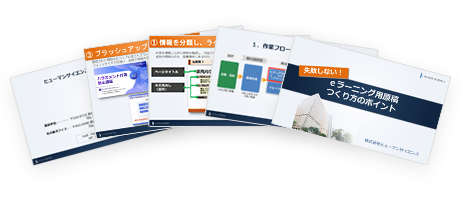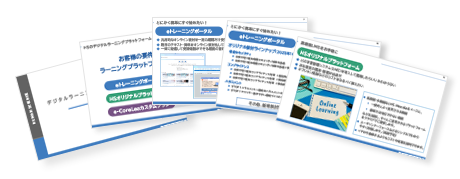2020.08.19
How to conduct group training during the COVID-19 pandemic? Is now the time to transition to e-learning?
The spread of the new coronavirus is still ongoing and the situation remains severe. Some may be considering switching to e-learning or online training instead of group training.
So, let's think about the differences between group training, e-learning, and online training, and what type of materials should be used for each type of training.

Table of Contents
1. How should training change after Corona?
2. Smartly use e-learning and online training according to the purpose and content of the training
1) Training type where the instructor explains and the participants listen, one-way type
2) Training that requires real-time and two-way interaction, such as discussions
3) Type where participants use their hands to learn practical skills
1. How should training change after the coronavirus?
The Ministry of Health, Labour and Welfare is encouraging new work styles such as telework, rotational work, staggered commuting, online meetings, and regular ventilation and mask wearing as part of the "new lifestyle." In particular, telework and online meetings are expected to continue even after the end of the COVID-19 pandemic.
In training, even in the post-coronavirus era, there is a demand for adapting to new styles. In the past, group training was common for training, but some companies are already shifting to e-learning and live online training formats.
Features of Group Training
- ・The instructor sometimes adjusts the direction by incorporating small talk and reading the atmosphere, and also includes discussions among participants to create a "live" atmosphere.
- ・Sometimes, stimulate your five senses while learning, and aim to achieve your learning goals by moving your body.
- - On the other hand, there are also disadvantages such as difficulty in preventing "3Cs" (closed spaces, crowded places, close-contact settings), longer time constraints, and costs associated with participants' travel and accommodation.
- ・Learner's progress is managed through attendance confirmation, post-lesson assignments, and report submissions.
Features of e-learning
- ・Can be taken anytime and anywhere, with no need to travel as long as the environment is set up
- - Watch and operate the learning materials that have extracted the essence of learning and organized the information while learning on the screen.
- - Compared to group training, it is often possible to complete the course in a shorter amount of time.
- ・If there are no special restrictions, you can access the teaching materials as many times as you want, making it suitable for repetitive learning.
- - Real-time exchanges such as Q&A and discussions are difficult.
- ・The learning status of participants is often managed through LMS (Learning Management System) and other systems.
Features of Online Training (Live Format)
- ・No need to gather in one place, you can participate from home, but the instructor and students participate at the same time
- ・Many companies use web conferencing systems such as ZOOM and Microsoft Teams
- ・Real-time interactions such as discussions can be done, just like in group training.
- ・There is a possibility that only that learner cannot study when a communication trouble occurs
- ・Learner's progress is managed through attendance confirmation and camera usage.
Each type has its own advantages and disadvantages. Instead of narrowing down to one, it is important to think about "using and combining according to the purpose and content of the training" in the post-corona era.
2. Use e-learning and online training wisely according to the purpose and content of the training.
To safely conduct training while avoiding the three Cs, it is recommended to primarily use e-learning and online training, and only hold in-person training for necessary content that requires physical presence.
1) Training with one-way communication where the instructor explains and the participants listen.

Training where the instructor's explanation is the main focus is recommended to be replaced with e-learning. e-learning is suitable for learning general knowledge and rules such as "information security" and "compliance" as it is easy to retain knowledge.
In particular, if there are training materials available, they can be easily used as materials to create e-learning materials in the form of videos or html5.
Tips for e-learning
- ・Incorporate important information from the instructor's verbal supplement into e-learning materials
- ・e-learning is not suitable for long-term learning as it is for self-study. Summarize it for about 20-30 minutes and divide the course if it overflows.
- - Viewing only text on the screen is painful and leads to decreased motivation. Make the screen easier to view by including photos, charts, illustrations, etc.
- - Prepare a confirmation test to ensure better retention of knowledge
[Case Study] Transforming Training Materials into e-Learning Content
- Before: A company, A, has been conducting group training sessions to learn internal rules and laws such as harassment and personal information protection laws. The training sessions take 2-3 hours each, and there have been complaints from participants saying they cannot make time because they are busy.
- After: Converted PowerPoint materials for group training into e-learning. Human Science writers organized the content based on approximately 50 pages of materials and added illustrations and photos to aid understanding. Created a 20-minute instructional material with simple animation.
Not only were learners able to learn in a short amount of time, but it also reduced their burden. Additionally, it is now easy to make revisions when there are changes to rules or laws, allowing for efficient education.
2) Training that requires real-time and interactive discussions, etc.

For trainings where not only the instructor but also the participants need to speak, online training is suitable. By turning on the camera on the participant's side, facial expressions can be confirmed, allowing for communication between participants.
However, if it becomes just listening to the instructor's explanation, the learning effect will not improve. It would be beneficial to consider a mechanism to increase the learning effect by combining with e-learning.
Tips for Online Training + e-Learning
- ・Conduct pre-learning through e-learning and limit online training to only Q&A and discussions
- ・After the online training, conduct a confirmation test with e-learning to ensure knowledge retention
- ・For screens such as PCs, it is difficult to maintain concentration for long periods of time. Take breaks as needed and divide your days.
[Case Study] Conducting Pre-Learning for Online Training with e-Learning
- Before: Company B has decided to replace their in-person group training for improving sales skills with online training. While they can use web conferencing tools for discussions and role-playing, they were unsure if a full day of online training would be effective due to the time it takes to cover basic knowledge as well.
- After: We propose a system to learn the basic knowledge in advance through e-learning. We have created multiple short courses of about 10 minutes each so that learners can learn during their free time and reduce their burden. We also provide a mobile-compatible LMS so that learners can learn in advance anywhere and make effective use of their time.
3) Practical skills acquisition, hands-on type for learners

The most difficult aspect of replacing traditional learning with e-learning or online training is mastering practical skills.
For example, learning how to use tools or operate large machinery requires hands-on experience and cannot be easily learned without gathering in a physical location with an instructor.
Therefore, it is necessary to focus on group training while also finding ways to reduce the amount of time and frequency of in-person gatherings.
Tips for Group Training + e-Learning
- ・Prepare operation procedures, videos (recordings of actual operations), and other basic knowledge as e-learning materials, and conduct pre-learning.
- ・Group training focuses on practical skills and Q&A sessions.
- - By actually touching the tools during group training, it becomes easier to understand the image. Therefore, after the training, we will conduct e-learning again and work on the test to further solidify our knowledge.
- ・Make sure that the content of e-learning can be viewed at any time, so that it can be reviewed again when using the tool in actual work
[Case Study] The instructor's demonstration is video-recorded so that participants can learn by watching it before the group training.
- Before: C Company, which had been conducting practical training for various tools and machines through group training, was struggling with the cost and burden of having instructors visit multiple locations and having participants gather multiple times, as the participants were located all over the country.
- After: While group training for practical skills is necessary, we also focus on conducting lectures during group training. In addition to converting the lecture portion into e-learning, we also propose a structure where participants can learn a certain amount of practical skills before the group training.
We believe that "watching the instructor's demonstration" is the most helpful, so we have a filming crew record the instructor's demonstration at the training facility and create a video with captions. By combining this with the lecture portion, we have significantly reduced the cost and burden of group training.
Training is not just about conducting it. The purpose is for participants to gain knowledge and skills that will be useful in their work. Therefore, in the midst of restrictions due to COVID-19, it is necessary to consider "how to effectively learn" and "how to ensure that participants can learn satisfactorily".

Author:
Sayoko Shirochika
Education Solutions Department Production Group
Writer/Consultant
・13 years of experience as an e-learning content production director
・11 years of experience in e-learning content writing
・Involved in writing scenarios for e-learning content
・Currently responsible for instructional design, scenario creation, and in-house support consulting
Contact Us:
Phone Number: 03-5321-3111
hsweb_inquiry@science.co.jp
No Failure!
Points for Creating e-Learning Manuscripts
We will focus on the brush-up parts of the materials already created for use in group training, and explain points to note and areas for revision.

【Content】
- Let's check the workflow.
- Let's polish up the slides.
①Classify and label the information
②Organize and layout the information
③Polish up
Latest Blog
- 2024.04.02
- English Learning Using Moodle and ChatGPT












